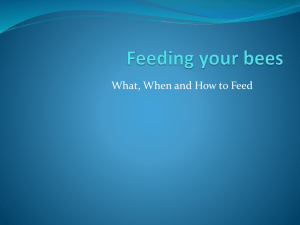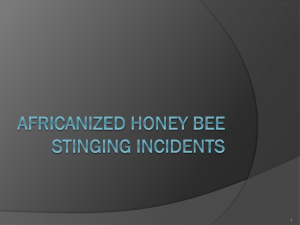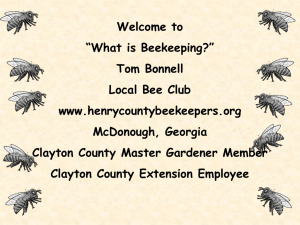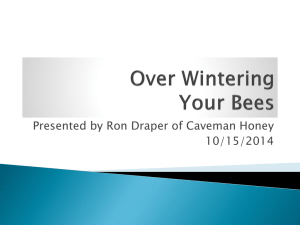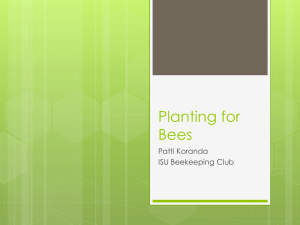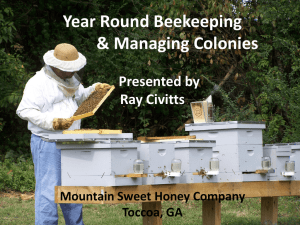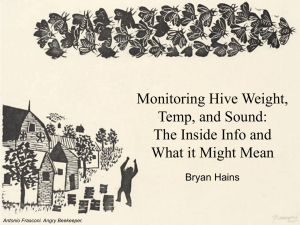The Sheldon Honey Bees - Toronto Outdoor Education Schools
advertisement
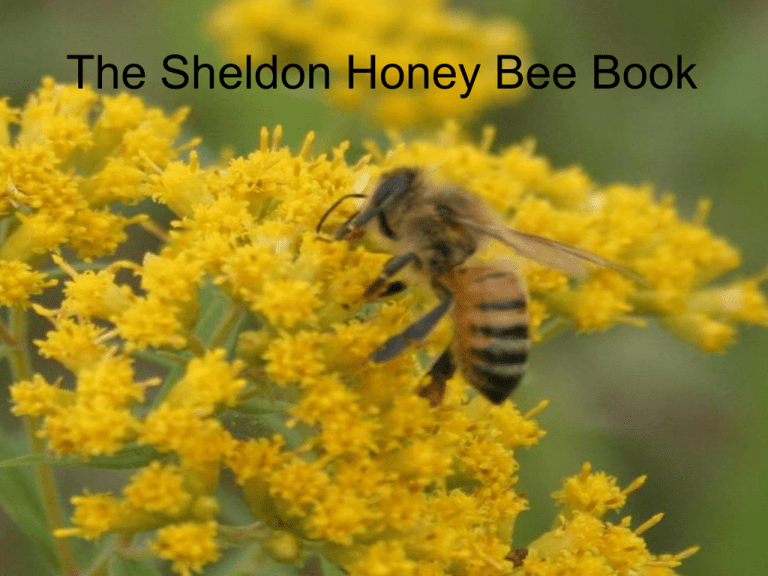
The Sheldon Honey Bee Book The Sheldon Honey Bee Book Written by Steve McElroy Photographed and Edited by Steve McElroy Andy Kennedy Tricia Barrett Paul Thornton Nicole Espenant Tracy Carreau Brenda Carling March, 2010 All photos taken at Sheldon Centre for Outdoor Education, Toronto District School Board Table of Contents What is a Honey Bee? 4 Why Bees are Important 5 Life of a Honey Bee Larvae The Queen Drones Workers Cleaning Cells Feeding Larvae Comb Construction Making Honey Guarding Foraging 8 9 10 11 12 13 14 15 16 17 19 Beekeeping Checking Hives Adding a Queen Disease Collecting Honey End of the Year 22 23 29 30 32 38 Words in italics are in the glossary What is a Honey Bee? Potter Wasp Honey Bee Bumble Bee The honey bee is one of the thousands of bee species in the insect class. Many bee species live alone. Honey bees live in colonies of 50,000 or more. The colony can survive through the winter by eating honey. People often confuse bees and wasps. Bees are hairy and less aggressive than wasps. Why Bees are Important Tiny yellow pollen grains are sticking to the hairs on this bumble bee Millions of years ago, bees and plants with flowers evolved to depend on each other. The bees need pollen and nectar from flowers for food. The plants need bees to spread pollen between flowers. This is called pollination. The pollen is needed so the plants can grow fruit containing seeds. The seeds are spread by animals that eat the fruit. The bees, the plants, and the fruit eating animals all need each other for survival. The entrance at the bottom can be covered if this colony is moved Many kinds of insects act as pollinators. Honey bees are especially important to people because beekeepers can move colonies to crops and orchards that are too large to be pollinated naturally. About one third of our food comes from plants that need to be pollinated. These apples started as flowers requiring pollination Just a few examples of bee-pollinated foods are apples, oranges, strawberries, pumpkins and almonds. Bees also pollinate crops like clover and alfalfa that are fed to animals raised for meat and dairy products. Honey bee pollination services are much more important to humans than the honey and wax that bees also provide for us. Life of a Honey Bee The frames containing the wax cells can be removed for inspection Bees cooperate so well that a bee colony (also called a hive) appears to behave as one animal. Each bee instinctively performs the tasks that help the colony survive. A colony needs a queen, many thousands of female workers, and several dozen male drones. Larvae Adult workers, capped larvae and uncapped larvae After three days an egg will hatch into a helpless larva. It grows very quickly. The larva is fed by adult bees for five to seven days before its cell is capped over with wax. While it is capped it will pupate then emerge as an adult bee. The time from the egg being laid to emerging as an adult bee is 16 days for a queen, 21 days for a worker, and 24 days for a drone. The Queen The queen can lay more than a thousand eggs per day The queen is the mother. When a new queen is needed, the workers continuously feed a few worker larvae large amounts of royal jelly. The first queen to hatch stings the others to death, or fights if another queen emerges at the same time. After a one time mating flight, the queen might not leave the hive again. There can only be one queen. Drones Many workers and one drone Drones cannot sting Drones are large, male bees with big eyes. They must be cared for by the worker bees. The strongest and fastest might mate with a queen on a mating flight. Drones die immediately after mating. Since they are only needed for reproduction they are forced out of the colony before winter. Workers This worker is collecting nectar to make honey Workers are female bees but they cannot lay fertilized eggs. Most of the bees in a colony are workers. They are extremely important to the hive because they perform many, many duties that the colony needs for survival. The tasks workers perform can change according to their age, the season and the needs of the colony. Cleaning Cells These cells were cleaned and are now being used to store pollen After emerging as adults the workers begin tasks such as cleaning cells. The cells can now be used to store honey, nectar and pollen. They are also used by the queen to lay eggs. Feeding Larvae Larvae can double in size in one day After three days workers are old enough to feed larvae. The larvae need a lot of protein to help them grow. The protein comes from the pollen collected from flowers. This is why the pollen is usually found next to the larvae inside the hive. Comb Construction These freshly-made cells are being used to hold nectar At thirteen days old workers’ bodies are able to produce bits of wax that they use to build six-sided cells. Engineers will tell you that a hexagon shape is the best shape for maximizing strength and storage space. Making Honey After nectar has been turned into honey the bees cover it with a wax cap Another task workers might begin at thirteen days old is turning nectar into honey. The bees add enzymes produced in their body to change the type of sugar in the nectar. They also fan the air with their wings to evaporate some of the water in the nectar. Fanning can also control the hive temperature and provide air flow. 14 Guarding Bees at the entrance could be arriving, leaving or guarding the hive At eighteen days old some workers will start guarding the hive. You might see them hanging around the entrance at the bottom. Many animals including wasps, skunks, bears and bees from other hives would love to eat the larvae or the honey. If something threatens the hive, or does not have the right smell, the workers may sting it to protect the colony. This wasp (called a yellowjacket) was killed because it tried to enter the hive Stingers have a poison sac and barbs that stick into mammal skin. A honey bee dies when it loses its stinger. Stings are relatively harmless to people, but they can kill an insect. A stinger should be carefully scraped out of skin to avoid squeezing the poison sac. A few people have a serious bee allergy. Just as people with a peanut allergy should avoid peanuts, those with a bee allergy should avoid bees. Foraging Workers visit many flowers on each trip, spreading pollen as they travel When worker bees are three weeks old they become foragers. Foragers collect pollen, nectar and water. A few gather resin from buds to make the sticky, dark red propolis that is used to seal up the hive. Foragers are also called field bees. Pollen baskets are attached to the back legs of worker bees Pollen that gets stuck to a bee can be scraped into its pollen basket. The pollen it misses, or ignores because it is collecting nectar, can pollinate other flowers. If a bee finds a good source of flowers, it will communicate the location to the other bees with a waggle dance inside the hive. The shape, colour and smell of a flower are all designed to attract pollinators. The shape of a flower helps pollen stick to the hair on a bee Nectar is the bee’s reward for coming to the flower. Nectar is carried in a honey stomach and regurgitated when the bee returns to the hive. Sugar from nectar is the source of food bees need to fuel their activities. Collecting wears out a bee’s body parts, causing foragers to die when they are about six weeks old. In winter, workers are able to survive until spring. Beekeeping The Sheldon Apiary Beekeepers have a lot of responsibilities. They must visit a bee yard regularly to help keep the bees strong and healthy. A hobby beekeeper might have a few hives. A commercial beekeeper might have hundreds of hives. A bee yard is also called an apiary. Checking Hives Students at Sheldon are able to hold and inspect the frames in a hive Humans collected food from wild honey bees thousands of years ago. Europeans brought honey bees to North America hundreds of years ago. Modern hive boxes are designed to allow beekeepers to look inside or remove extra honey without destroying the hive. A student examining activity at the entrance You can tell a lot about the health of the colony by watching the entrance. If you see many bees bringing pollen into the entrance on a warm day the bees are probably raising larvae. Honey bees don’t like to leave the hive when it is cold or rainy. Students at Sheldon wear a protective bee suit when working with bees Beekeepers usually wear a veil to protect their face but do not always wear a protective bee suit. This is because the suits can be hot to wear and the bees will usually not sting if they are treated gently. A small amount of smoke is used to calm the bees Beekeepers use a smoker to calm the bees when they work with a hive. The smoker helps hide the smells (called pheromones) the bees produce to alert each other to danger when they are alarmed or killed. The hive tool is being used to pry apart frames stuck together with propolis A hive tool and a frame lifter are used to help take out the frames for closer inspection. When checking a hive, beekeepers look for the amount of young larvae, capped larvae, adult bees, pollen and honey. They also check on the overall health of the colony. A frame from a healthy colony A commercial beekeeper will often transport healthy colonies to farms to pollinate the crops or orchards. The farmer pays the beekeeper for these important pollination services. Adding a Queen A new queen is kept in a cage for several days until the bees accept her A queen can live for several years, but beekeepers often replace a queen after 2 years. Beekeepers want queens that produce gentle bees that keep the colony clean, produce large amounts of honey, and are not likely to swarm. Swarming happens when a large colony divides and the old queen leaves to find a new home with part of the colony. Diseases Medication to prevent a disease called foulbrood Formic acid pads reduce the number of mites in a hive Mites, wax moths, foulbrood, nosema and a new problem called colony collapse disorder all harm bee colonies. Beekeepers add medication or use organic methods to prevent or treat unhealthy conditions. A varroa mite is on the thorax of this worker Mites are tiny arachnids that live on or inside individual bees. Mites have become such a big problem that wild honey bee colonies usually do not survive. Beekeepers will add formic acid pads or put a screen on the bottom of the hive to control mites. Collecting Honey The wires on the queen excluder will not allow the queen to fit through As a colony grows it needs more space to store honey. A beekeeper will add another box, called a honey super, to the top of the hive. A screen called a queen excluder goes between the honey super and the rest of the hive to keep eggs out of the honey. No medication is used when the honey supers are on. This hive has one honey super on the top of the colony Sometimes more than one honey super is added to a strong colony. The supers are removed at the end of the summer so the honey can be put into jars for people to eat. This does not hurt the bees as long as enough honey is left in the hive for the colony to survive the winter. A capping tool is being used to remove the wax capes covering the honey After the honey is collected the wax caps are removed. The caps are collected and cleaned. The wax can be used for high quality candles and many other products. Each frame can contain over a kilogram and a half of honey. Spinning causes the honey to spill out and collect at the bottom Next the uncapped frames are put into an extractor that spins the frames and removes the honey. Nothing needs to be added to the honey to make it ready to eat. Honey pouring out of the extractor Pouring honey through a filter The honey is put through strainers and filters to remove bits of wax before going into jars. Honey is unusual because it will last for years without refrigeration if you keep it sealed. Honey will usually granulate (turn more solid) after a few months, but it can be liquefied again if you warm it up. A ribbon won for Sheldon honey A jar of granulated honey Beekeepers often sell jars of honey as a part of a business. Some beekeepers enter their honey or wax into competitions. The colour and flavour of honey varies with the qualities of the flowers the bees used to make it. Consider trying some honey made in Ontario. End of the Year Hives with a winter cover As winter comes, beekeepers wrap the hives to help keep out the cold. The bees cluster together inside the hive to keep warm. Now the bees will survive on their honey supply until the flowers return to make them busy once again. Glossary Words in the book written in italics are listed here Arachnids a class of animals including mites, spiders and scorpions that have eight legs as an adult Bee Yard an area where honey bee colonies are kept Bumble bee larger and hairier than a honey bee. Only the queen survives the winter. Many species are native to Canada Colony a group of the same species living and working together Commercial operating as a business to make money Enzymes proteins that help cause a chemical reaction Evaporate to turn liquid into vapour. Bees remove water from nectar to help turn it into honey Frame lifter a hinged beekeeping tool designed to lift and hold the frames inside a bee hive Hive tool a multi-purpose beekeeping tool with a flattened end that is useful for prying or scraping equipment larva(e) the stage of life between egg and pupa. The plural of larva is larvae Pupate turn into a pupa. This is the stage in complete metamorphosis when a larva changes into an adult insect Regurgitated brought back up from the stomach Royal jelly a high protein substance produced in the glands of worker bees Waggle dance honey bees waggle their abdomen, and run in a circle or figure eight, to show the direction and distance of a flower source

